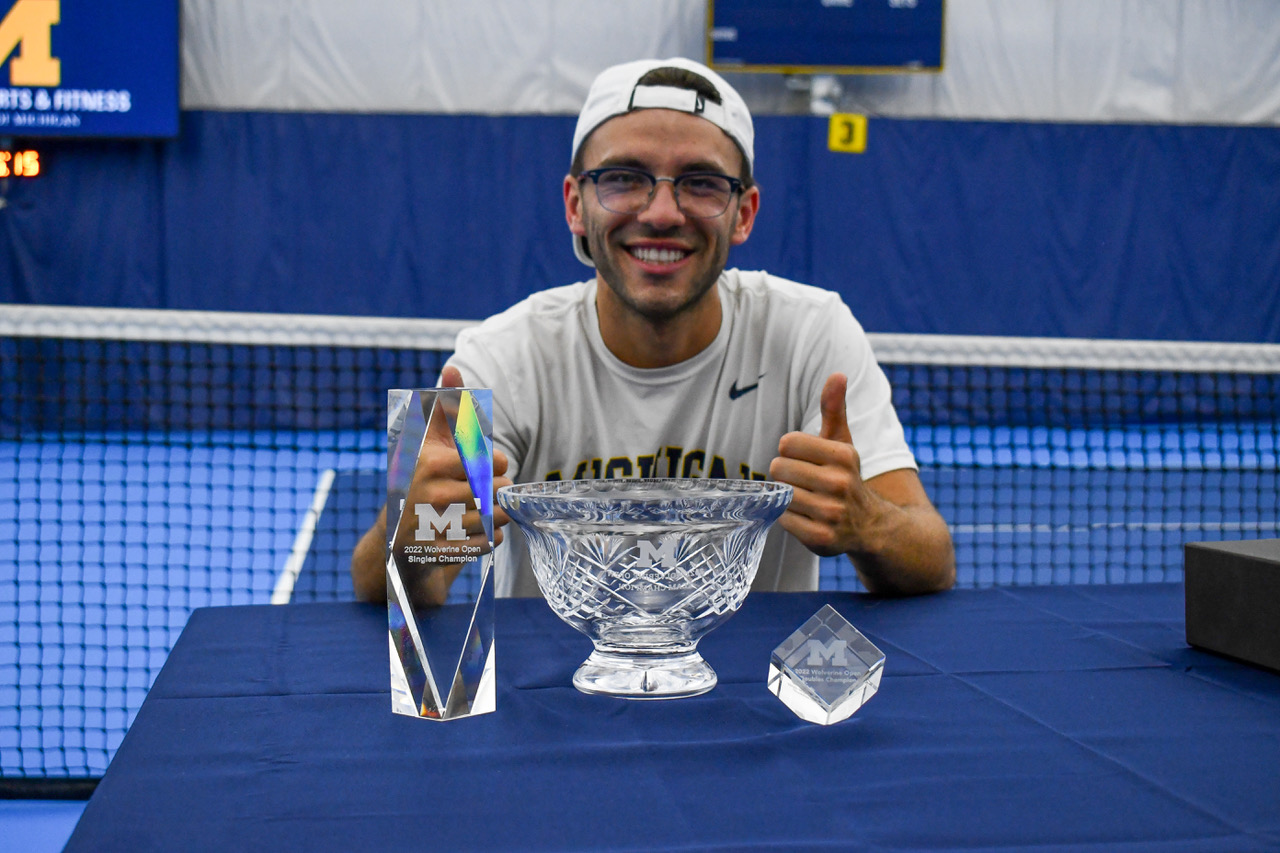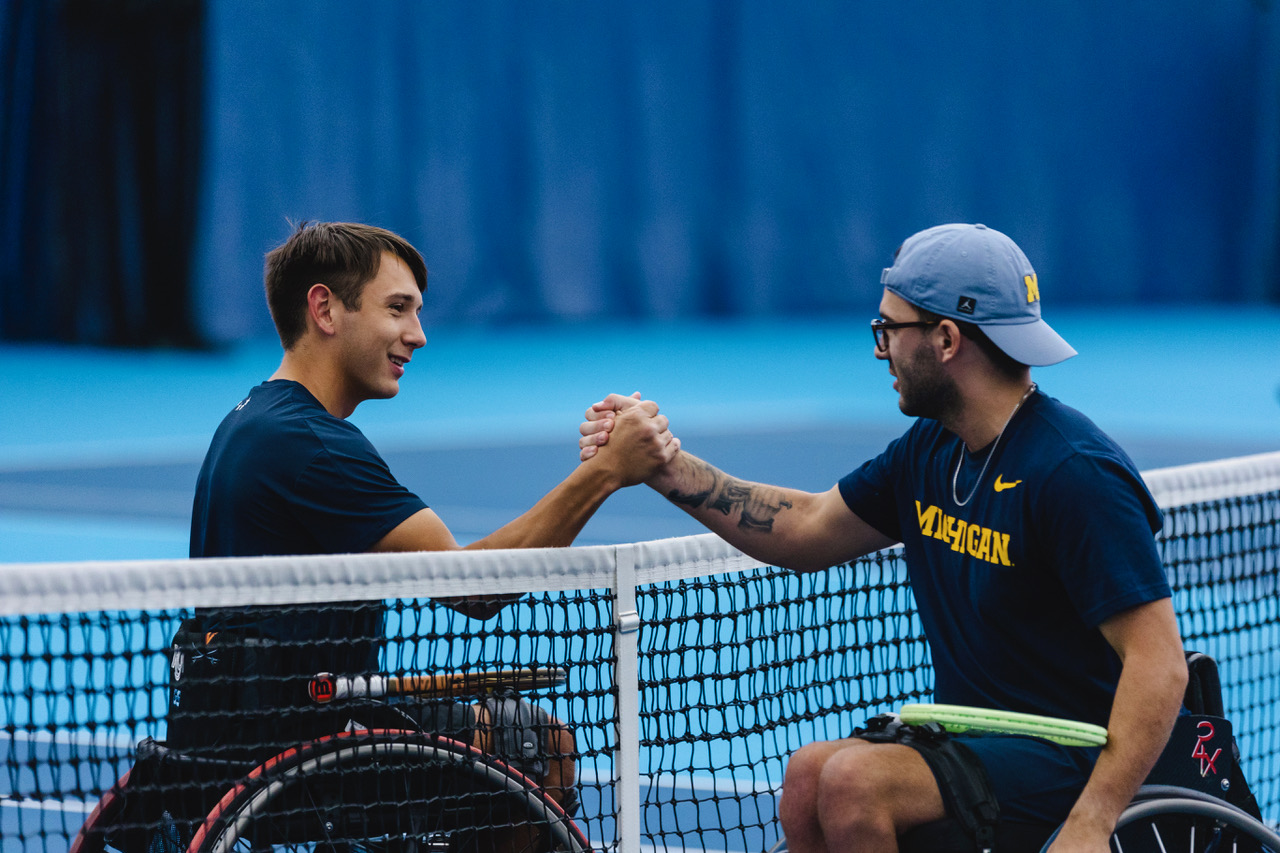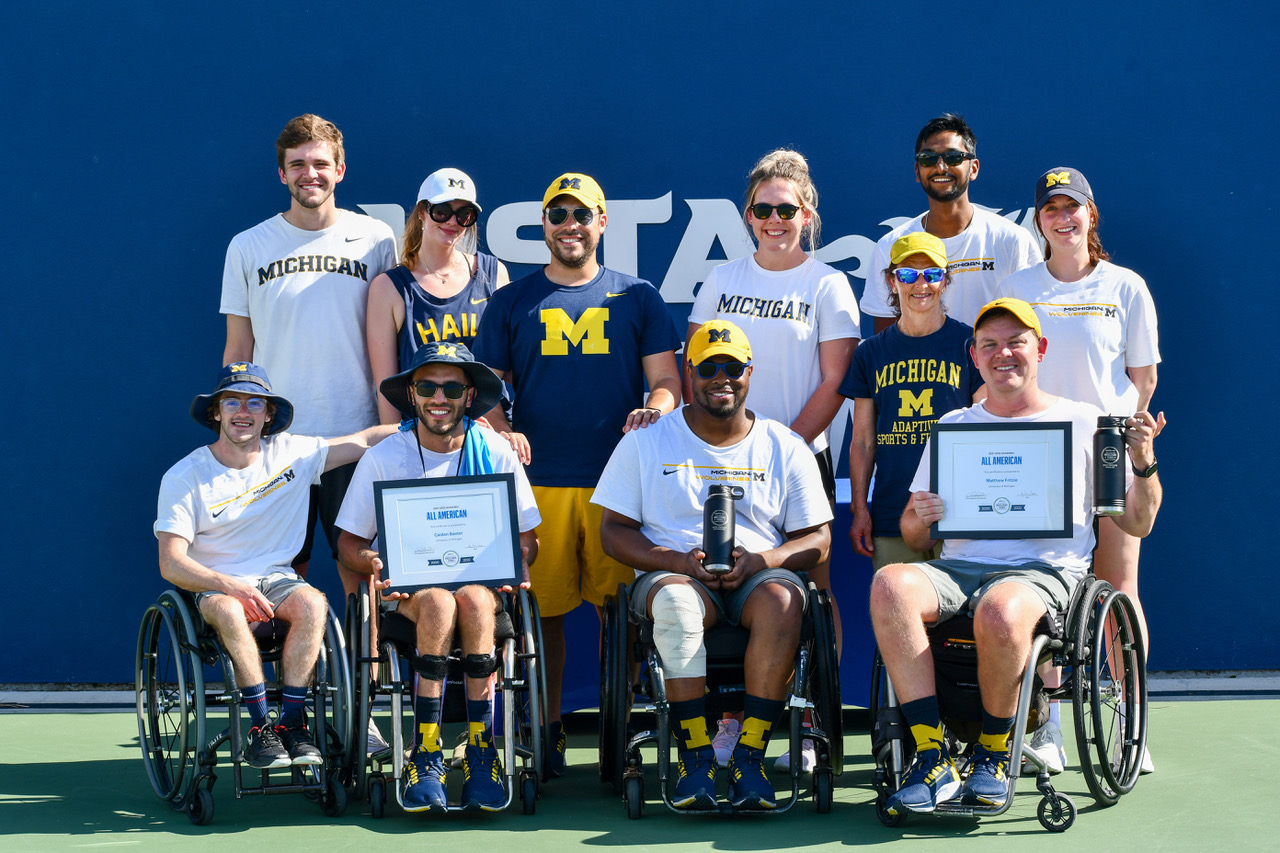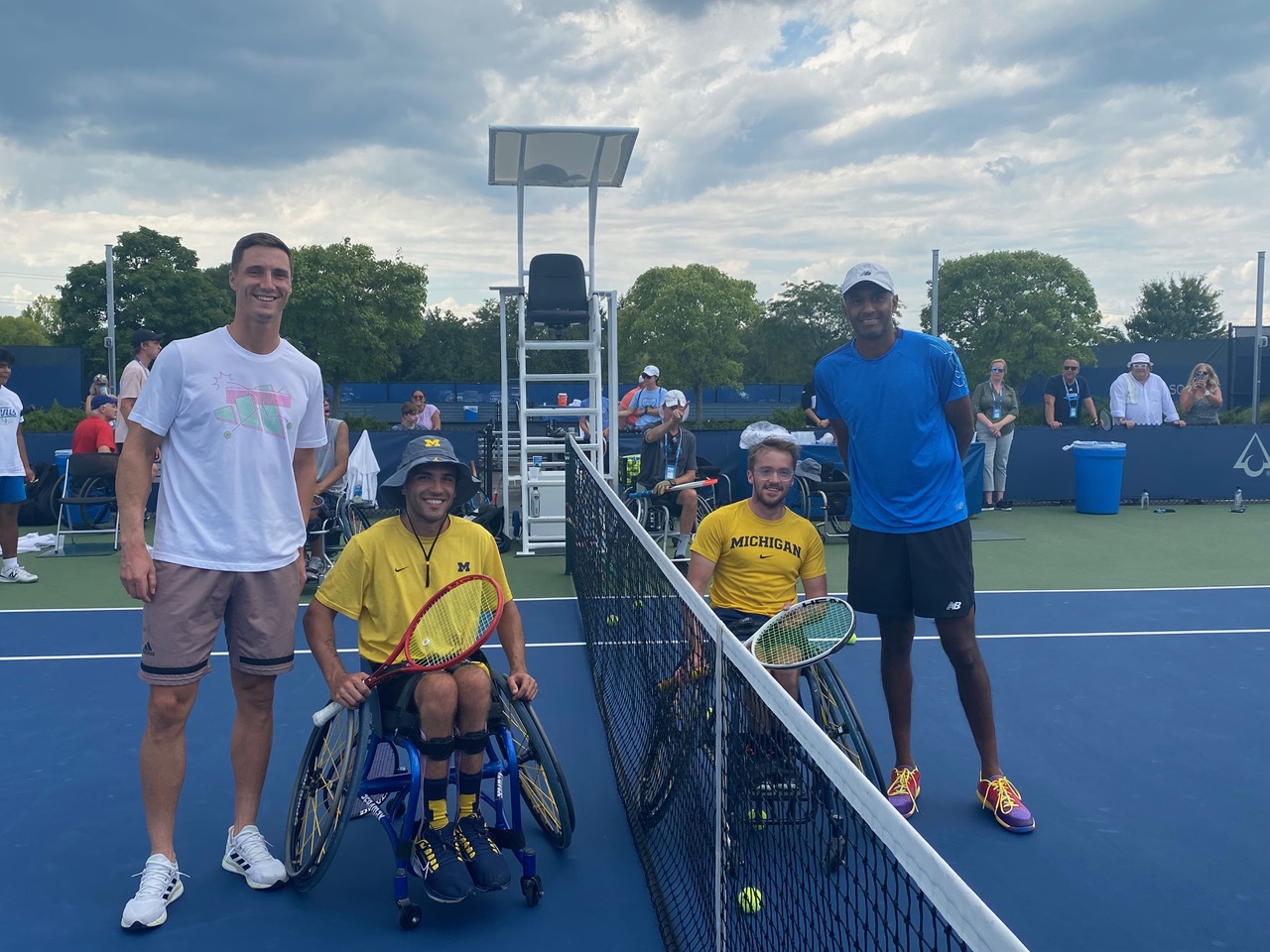
 Back to News
Community Impact
|
Student Success
Back to News
Community Impact
|
Student Success
In conversation with...Caiden Baxter

As a kid, Caiden Baxter wasn’t like everyone else.
At age 13, he was taking night classes at a local community college because he'd excelled academically and wanted to challenge himself.
An avid athlete, he was also playing baseball and basketball. But that changed at age 15 when a four-wheeler accident injured his spinal cord.
“Excelling before being injured and then experiencing something that changes your everyday life and every element possible — I didn’t know what that was going to look like,” Baxter says. “Thankfully, I had mentors and people to look up to that I already knew who flourish with a disability.”
Wheelchair basketball was Baxter’s first foray into adaptive sports, but he considered it a way to get some exercise in a hospital setting rather than a competitive outlet. It wasn’t until Baxter came to the University of Michigan on a full academic scholarship for undergrad, when family friend and Michigan Medicine assistant professor Feranmi Okanlami told Baxter he wanted to start an adaptive sports program at U-M, that the rest of Baxter’s life was set in motion.
Baxter, currently a master’s student in sport management, is now ranked no. 2 in collegiate wheelchair tennis in the country and no. 1 at the amateur level. He was one of the first adaptive athletes to sign a name, image and likeness (NIL) deal and recently became an ambassador with the Kelly Brush Foundation to spread awareness about adaptive sports and the available opportunities in the space. He sat down with us to talk about his experience as a student, an athlete, and a pioneer in collegiate adaptive sports.
Q: How did you start playing wheelchair tennis?
A: When I got to U-M as an undergrad, Dr. O [Feranmi Okanlami, now the director of U-M Adaptive Sports & Fitness] told me he wanted to start an adaptive sports program here at Michigan. We only needed one more athlete to create a wheelchair tennis team, so I said I’d do it.
At that point, in the first semester of my freshman year, it was just a once-a-week hit for more of a club-level team. Once we transitioned to varsity-level training and I made the decision that I wanted to continue, I went from once a week to six days a week of training. I didn’t actually compete in my first event until the end of the year at the National Championships in Orlando.
My sophomore year, we were known as the “Cinderella story” because no one had heard of us and we came out and took second, losing to Alabama in the championship. We had a very strong team for a brand new program. Through my junior and senior year, I was moving up from the C division, the lowest division for wheelchair, to the A division. I took a gap year after graduating from undergrad and was able to compete in 16 tournaments and take the no. 1 amateur spot for singles and doubles.
I wrestled then with whether I wanted to transition to playing professionally or go back to school and compete in the college draw. I ultimately made the decision to come back to U-M for a master’s in sport management and was offered a scholarship through the Neilsen Foundation. So I haven’t made the transition to pro yet. I don’t know if I will or not. Right now, I’m just excited to keep playing with the team. In November, I went to nationals and placed second in the A division, and that was amazing.

Q: Wow, that’s all incredible. What was it like for you to have this sport that was previously unknown to you for most of your life become so important?
A: It’s super cool. I played a lot of sports growing up, but it was always local sports; I never did travel ball. Now, I spend about 20 hours a week on tennis and strength and other initiatives Adaptive Sports & Fitness is involved in. I help with some administrative support for the program and help run drop-ins, so it’s a huge element of my life.
Being one of the inaugural athletes for this program and one of the first wheelchair athletes in the country to sign an NIL deal, I know I’m leaving an imprint here at Michigan and nationwide, so that’s awesome.
And it’s provided a lot of opportunities to meet great people and be a part of systemic change. Through the varsity athletics program, I’ve met Paralympians, Olympians, and high-level coaching staff. There are amazing connections here. That’s what Michigan is about — our huge alumni base and connection network.
Q: I wanted to ask you about your plans after graduation. You said you might not want to turn pro, and I know you’re studying sport management. What do you hope your future will look like?
A: To do one year pro, you’re probably spending about $40,000 in training and travel. If you win one large tournament, you make that back. But if you don’t…So I don’t know that the money will be there for pro. But I do think I will still play and train regardless. I love the sport. I can’t imagine going from playing five or six days a week to then nothing.
The biggest thing for me is figuring out where I'm going to live. There are hubs for adaptive sports around the country with access to discounted or free training, so I would be able to train without serious financial implications.
On the career side, I’d like to make sure I’m making an impact or I’m able to build something that’s making an impact. I do things right now like help with junior clinics for wheelchair tennis. The one that I coach at in Holland every summer has around 30 kids that come in. It's completely paid for by funding from the USTA [United States Tennis Association] and other corporate partners. If we could amplify that — turn it into a longer camp or work with an organization to be able to offer the clinics throughout the year — that would be great.
Or I’ve thought about running a tennis club and hosting wheelchair clinics and events within that. Or working somewhere like a university. Maybe I wouldn’t make as much money or have as much control over what I’m doing, but I’d know that every day I’m putting work in where I can see visible change.
Q: What has been your biggest takeaway from serving as a leader in adaptive sports?
A: The biggest takeaway for me is probably the ability to relate to people. The blessing and curse of having a disability is that everybody feels like you're approachable.
So it doesn't matter if it's a random person in the grocery store asking me questions that they shouldn't be asking me or if you see someone with a physical disability and you instantly feel connected because you know the similar struggle and work that you have to put in to then get to the same point that other people get to.
So I think it’s having that ability to relate to people and be able to lead them and show them by example that having a disability does not mean that you can’t excel, it just means that it might look a little different. And it’s not that despite my disability, I can still excel, it’s with my disability I can make an impact in my own life and in other people’s lives.

Q: I'm curious about your NIL deal. What did signing that mean to you as an athlete but also as a leader in the adaptive sports movement?
A: I didn't expect to get the NIL deal. It was my senior year of undergrad, and I knew that I had been picking up pace, but I was not at a point where I felt like I was top of the country. Now, if I applied for something like that, I would think that there's actually a chance. Back then, it was more like seeing the potential that I had. As an athlete, it validated that people are seeing that I will reach this level and I thought that was important.
But what was a lot more important for me was: The revenue sports are making a lot of the money in NIL — football, basketball. Occasionally, someone like Olivia Dunn will make a ton of money in gymnastics or something. But most of the time volleyball players, softball players, tennis players are not getting this money. That's even more so for people that are in adaptive sports. Even some Paralympians who are winning gold medals — they may be getting money from Toyota, who sponsors Team USA. But as an individual, they're not receiving as many opportunities for NIL.
So the $10,000 deal I signed with Degree Deodorant was a huge deal for the adaptive sports community, to show that there is opportunity in NIL.
The biggest impact it left on me personally was when I was talking with high schoolers and middle schoolers who weren't considering going to college because they were already at a high level where they could transition into pro. But showing them that there are good opportunities to get a free or discounted college degree, to get NIL money, to be able to compete at a high level, I think that will start encouraging high-level athletes to go to school.
Q: I had heard that Adaptive Sports & Fitness is now offering scholarships as well — is that the case?
A: So in the past, the available money has been through private organizations like the Craig H. Neilsen Foundation — we are a Neilsen Scholar school so every year, the U-M Office of Student Accessibility and Accommodation Services sends out information about Neilsen’s scholarship to anyone with a disability and you can apply. There's a lot of different scholarships like that, but that is not related to being an athlete; that's just related to having a disability.
But at U-M, we do now have specific scholarship funding that we will be able to give out through Adaptive Sports & Fitness, which is a huge way to offset the cost for the athletes that are here and a huge asset for recruiting. I think it's going to be very helpful to get more people access to college-level sport.
Q: You mentioned there are some adaptive athletes who are considering not going to college because they’re already playing at a high enough level to turn professional. But I’m guessing there are a lot more people who don’t find out about adaptive sports until later in life. What would need to happen for more adaptive athletes to be competing at a high level when they come to college — improved infrastructure? More funding?
A: The biggest thing is what you just mentioned: developing them at a younger age. To do that, you need access to equipment, access to training and funding, and then education for whatever community they're in.
I helped coach an able-bodied middle school team last summer. There were 52 kids, and none of them had ever seen wheelchair tennis, even though this was in Niles, Mich., where I grew up. I am known by a lot of people in my hometown, but none of them had known that wheelchair tennis was available. God forbid one of them could end up with a disability and need this, or maybe there’s someone in their life — young, old — who uses a wheelchair who doesn't know that this exists that could then come into the sport.
As a program, we develop educational packets to give to schools about how adaptive athletes can play on their high school team. We work with the USTA and with other corporate partners like the Kelly Brush Foundation and Challenged Athletes Foundation to have funds available for these athletes so they can get access to equipment and training. Some of the athletes just do private lessons once a week, and there's funds available to be able to pay for those as well. If they want to travel to tournaments, we have funds to get them there, to have their family stay in hotels, things like that.
I mentioned there are hubs of adaptive sports all over, and usually the hubs provide for people within a general radius. But making sure adaptive sports is widespread and having national organizations be involved and traveling around and sharing information with people is what's really going to further develop the space. I was just approved for an ambassador position for the Kelly Brush Foundation to be able to travel and talk about this a little more and host some events. It’s a pilot program, so they’ve never done it before. Hopefully we'll host an event here at Michigan at one point. A lot of parents don't realize that this stuff is available and if they don't know that it's available, they have no way of getting their kids access.
Q: Congratulations on the ambassador position, that’s awesome. Do you ever get tired of breaking ground in the adaptive sports space?
A: No. It’s pretty great. The fact that there's so many new things happening that are producing this rapid growth in adaptive sports is so cool. I just don't want it to slow down.

Q: Where do you think the interest is coming from for adaptive sports in general? It does feel like there's been this burst of momentum in that space. What factors have contributed to that?
A: Advancement of technology. It's no longer expensive to run broadcasts; my national championship match had cameras on every court that ran to ESPN+ because it didn’t cost that much to run those streams. So at this point, there's no reason not to provide streaming to all levels of sport, whether that be the advanced level of disability sport or high school sport.
Now that it’s not costing that much extra money to stream, it’s just some extra effort to be able to support these other athletes. Companies have started making it a corporate social responsibility tactic to show that they’re representing these athletes and they’re here to support them. Toyota being able to provide equal sponsorships for Paralympic athletes and Olympic athletes was huge.
These big steps in the last couple of years then demonstrate that we should provide equal opportunity for exposure to these athletes, and I think that trickles down. When the NCAA is posting me and Francesco Felici [who won the wheelchair tennis national championship this year] on their Instagram, it then trickles down and the University of Michigan is interested in what we're doing and other universities are interested in starting programs.
I recognize there's still a ton of room for growth. For example, some of the events we’ve done are labeled as integrated events, but they still feel like a wheelchair tennis event next to a tennis event and a wheelchair basketball event next to a basketball event. From three years ago to now, though, the landscape has gotten significantly better, and I think it will continue to improve and start feeling more natural and integrated. The fact that we’re on the same stage and being televised and promoted together — that is a huge step forward.
Q: Over the past maybe 10 years, college has become a significant pipeline for professional, able-bodied tennis players. Is the goal to create that same sort of pathway for wheelchair athletes, ultimately, to go to the pros?
A: When you look at the numbers, people with disabilities are less likely to have a college degree. So any way that we can get people to know that they can go to school, we can get their school either partially or fully paid for, and we can get them the administrative support to be able to make it through school and succeed on the other end of it, I think that’s a win. Sport is a great way for all people to go to school.
But absolutely, I think we need college adaptive programs to be at a level of intensity and prestige so that when people come into these programs, they come out a significantly more developed athlete and are able to then go pro. If you see a school that doesn't have a great able-bodied basketball program and you want to play in the NBA, you're not going to want to go to school there because you don't think you're going to get better. If you can get to a point where you have high-level coaching, you have high-level athletes all in the same area, people are going to be more interested in going there.
The other aspect is: When you play in college, you're a lot more likely to end up in a coaching position at some point in your life. So we need people in the world that know about adaptive sports, that have experience with adaptive sports, to, 5, 10 years from now, become the coaches that run these programs. And I think that going to school, especially a place like U-M that has really strong infrastructure and concrete things that you can use to start up a program — manuals, literature, resources, and people available to help you do this — getting involved and connected with a program like that then makes it easier to have an impact.
That's where we excel: We have access to really good coaching, we have access to great education, we have great athletes and being able to put all that together is appealing for people. Our only struggle is that U-M is not very easy to get into.
Q: From a sport management perspective, what has it been like being in that program as a master’s student?
A: My first semester just wrapped up. It's been amazing. We just presented to Ilitch Sports + Entertainment and seeing all of the SM alumni that are working in that organization and all the other SM alumni that have had real-world, super cool jobs has been incredible.
So far, the Sport Management Program has been significantly more enjoyable than my undergrad at Michigan. I didn’t mind my undergrad, but I'm a lot more interested in this topic. The professors are really easy to connect with. I've already gotten involved in research and other projects and have been able to connect them to Adaptive Sports & Fitness. They’re all very interested in getting involved.
And my cohort is amazing. I think everyone's eager to be here. Because this program does not have a very high acceptance rate, the people that did get in are grateful and appreciative and here to make an impact, and we've had some impressive results from that.
Q: Are there already classes here that discuss disability in sport?
A: I just took “Diversity in Sport” with Dr. [Ketra] Armstrong. She covers a lot of topics over the semester, but she does a good job touching on adaptive sports. There's been talk about a couple courses being offered that are strictly about adaptive sports, either capstone courses or undergrad electives. I think that would be good because there is so much to cover. For our “Diversity in Sport” class, my team did a literature review of adaptive sports; it was around 60 pages, and we felt like we didn't really touch on everything that we wanted to.
I’d also love to see the “Diversity in Sport” course connect with Adaptive Sports & Fitness to do a “try it” day. We already do that with medical, physical therapy, and movement science students. We’ve played wheelchair ultimate football, tennis, basketball, pickleball, seated volleyball — there’s lots of ways we can run these kinds of programs and let people try out the chairs and the sports. When they do that, I think it produces a level of respect. Once you get in the chair, you realize how difficult it is.
We've done these “try it” days with professional players, like Rajeev Ram [former world no. 1 in doubles and six-time Grand Slam champion]. We've done them with the varsity men's team a couple of times. A lot of times, people are worried about offending someone or they're worried about getting involved and what that might look like and they shy away from adaptive sports because it's easier. But this is a good, low-stress way to introduce people to the sport. And getting as many people involved and exposed to adaptive sports is my goal.

Baxter and U-M Adaptive Sports & Fitness assistant director Christopher Kelley grin next to professional doubles players Joe Salisbury (left) and Rajeev Ram (right).
Want to learn more — or try out — some adaptive sports? Sign up for the U-M Adaptive Sports & Fitness newsletter or check out the program’s website for more information.